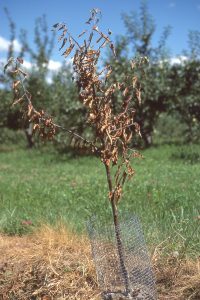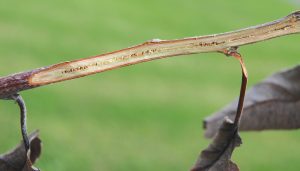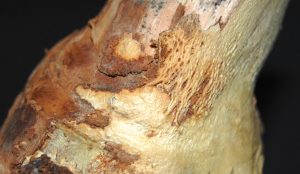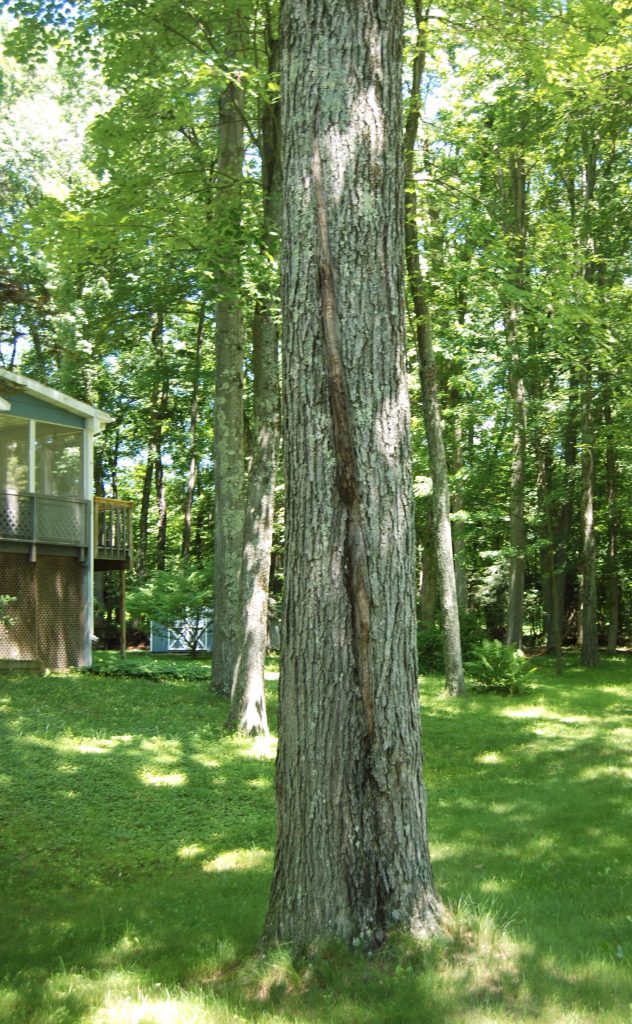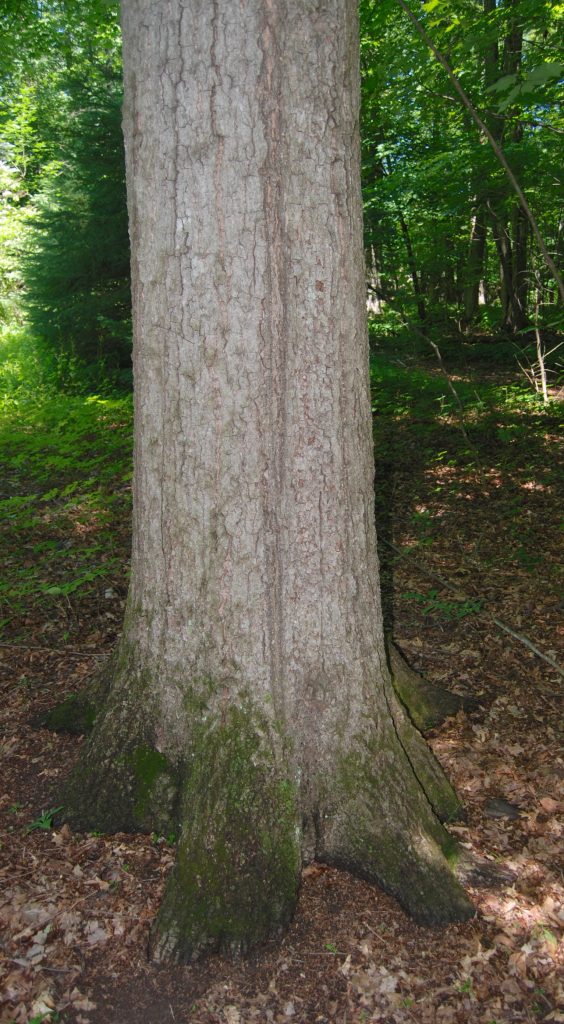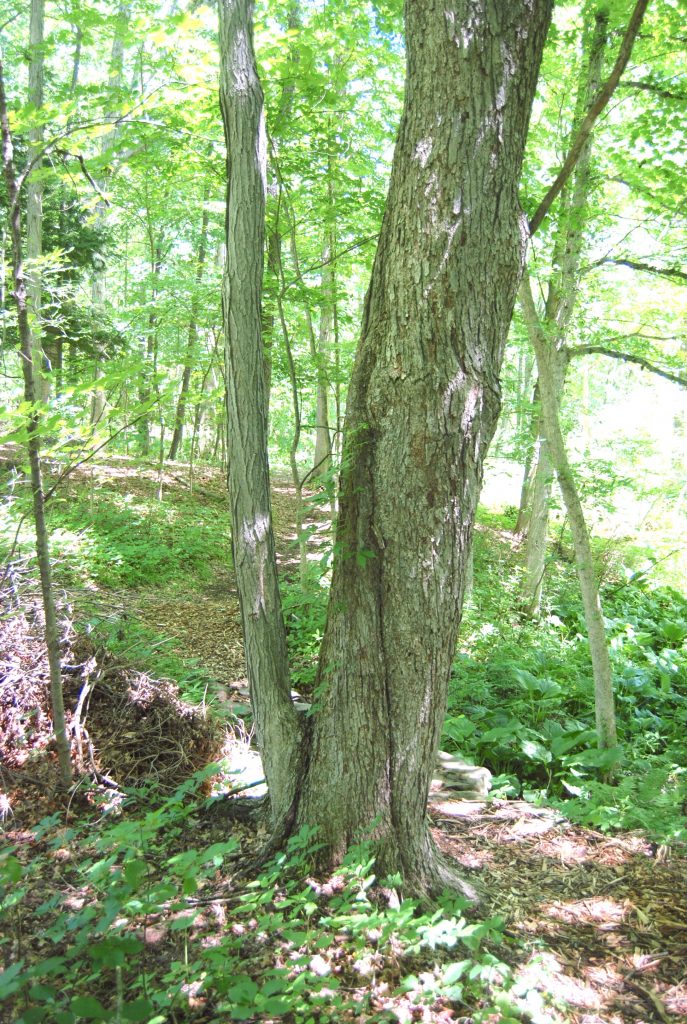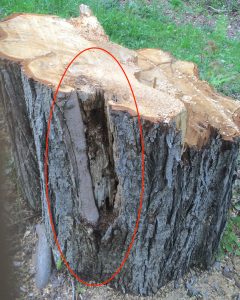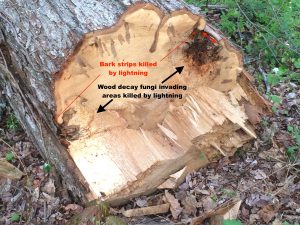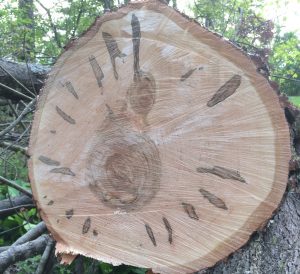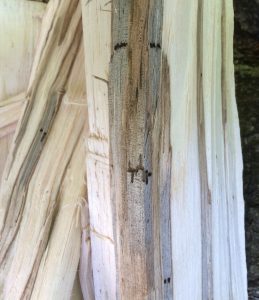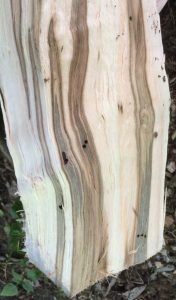(Parts of the following commentary were published in
Scaffolds Fruit Journal on 26 June 1917.)
Lightning damage in apple orchards is not especially common, but when it occurs it often causes great consternation because trees that were completely healthy one day will have browned leaves and dead bark just a day or two later. I’ve been called to diagnose tree deaths caused by lightning only about six or eight times over the past 35 years. In all of those cases, growers were concerned that whatever killed the tree in question might spread to the rest of the orchard. That concern carries special urgency if fire blight has already been detected in the area. The good news about trees killed by lightning is that this kind of “fire blight,” although deadly, is not contagious.
Lightning strikes on large forest or shade trees will sometimes knock the bark off of one side of the tree where the electrical charge heats the sap to beyond the boiling point (see https://extension.umd.edu/hgic/lightning-damage-trees-and-shrubs). During my career, I have seen this kind of injury on only one apple tree, and that was many years ago in a very large old tree that had been injured many years before my visit (Fig. 1). Sometimes trees are completely killed (Fig. 2), and the trees that are killed may not be the tallest trees in the area of the strike. Usually lightning damage in apples creates more subtle injuries, but lightning damage is relatively easy to diagnose if one knows what to look for.
- Fig. 1. An old lightning strike that led to wood decay on one side of tree.
- Fig. 2. A young replant tree killed by lightning while nearby taller trees were unaffected.
When just one or two trees in large plantings die suddenly during summer, I usually suspect lightning injury. If trees are supported by wires, then all trees between two support posts may be injured or killed. To verify lightning as the probable cause of tree death or injury, one can look for additional evidence to support the lightning hypothesis. First, did thunderstorms occur in the area anytime in the past several weeks? If so, then the next steps involve looking for some of the following telltale signs of lightning injury:
- Brown-black leaves are still attached because a branch or tree killed by lightning has no time to form an abscission layer (Fig. 2),
- The killed leaves may have sharply bent petioles (Fig. 3a), presumably because the rapid desiccation caused by the heating deforms the normal arc of the leaf petiole.
- Tangential cuts through recently killed terminal shoots may show “pelletized” pith in the center of the shoots (Fig. 3a,b) because the pith contains more water than other shoot tissue and therefore shrinks into distinct segments or “pellets” when it is desiccated by the electrical charge.
- Fig. 3a. Segmented pith in the top of the tree shown in Fig. 2. Also note sharply angled leaf petioles.
- Fig. 3b. Pelletized pith in a shoot recently killed by lightning
- On trees that are not attached to a trellis, one or two trees at the center of the strike may be completely killed, but the tallest twigs or limbs on adjacent trees may show dieback caused by parallel charges that are of lower intensity than the main charge. The lesser charges that kill shoot tips in adjacent trees but dissipate to sub-lethal levels as they move into heavier wood, thereby killing only the smaller and most exposed shoots on adjacent trees.
- In southeastern New York, trunks of apple trees killed by lightning are sometimes covered by fungal bracts (shelf fungi) within several weeks after the lightning strike occurred. These bract fungi can sporulate very quickly on the killed trees because they were already present in the discolored xylem that is often evident in cross-sections of older trees. The tree’s natural defenses limit the growth of these xylem-invading fungi, and they can only sporulate (form bracts on the tree surface) when they are able to progress outward all the way to the bark surface. When lightning kills a tree, the killed wood and the water it contains provide the perfect growing conditions for these fungi, so they rapid colonize the wood killed by lightning and produce bracts.
In some cases, trees may be injured but not killed by lightning, or just a few twigs or branches may be killed and the damage may not be noticed immediately. When such damage is noted several weeks after the lightning injury occurred, tangential cuts made through small branches just below the killed area often reveal ovals of dead tissue killed by the lightning but overlaid by new xylem that was produced after the injury (Fig. 4).
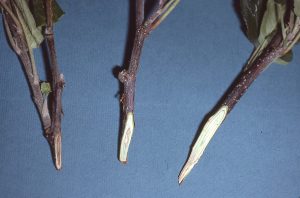
Trees damaged by lightning may attempt to recover, but they sometimes exhibit reduced growth and other decline symptoms. In one case, lightning damage killed sections of bark that appeared as cankers that were discovered the following spring whereas intervening sections on the same limbs still had live bark. After removing the bark from affected limbs, the darkened “cankers” where the cambium was killed by lightning contrasted sharply with the healthy white xylem where the cambium had survived and produced new tissue.(Fig 5). Cross-sections through areas of apparently healthy bark on the affected limbs revealed a ring of brown tissue beneath the bark, evidence of injury by the electrical charge from lightning (Fig. 6a,b).
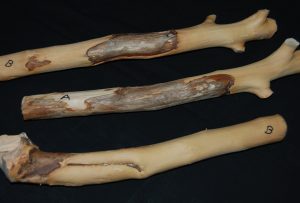

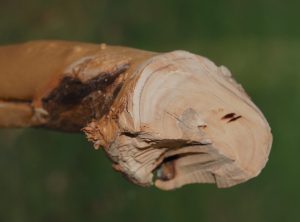
The bark on one side of the trunk near the base of the tree had been killed by the lightning, but new xylem was being produced in interesting patterns on the other side of the tree where the tree was attempting to recover from the underlying damage (Figs. 7-9). Trees with damage as severe as what is shown in Figures 7-9 are likely to be permanently disabled and in most cases will need to be removed.
- Figs. 7-8. Lower part of a young tree struck by lightning the previous year with bark removed to show killed areas of cambium on the left but new xylems forming over the damage (center and right).
- Lightning damaged trunk or a small apple tree showing xylem repair that occurred during the months following the injury
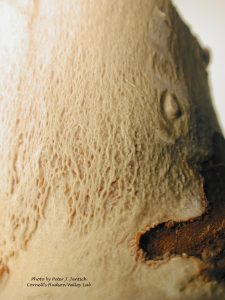
The ability to recognize lightning damage is useful because a correct diagnosis can allay fears that some unique disease or insect problem is about to destroy the orchard. Apple growers deal with many such threats, but lightning damage rarely causes extensive losses in orchards.
LIGHTENING DAMAGE ON FOREST AND SHADE TREES
My home is located on a wooded lot where, over the past 40 years, I have noted many tall shade trees with evidence of lightening damage (Figs. 10-13).
- Fig. 10. Vertical callus strip formed on red maple to heal lightning injury
- Fig. 11. Vertical lightning injury on pin oak.
- Fig. 12. Spiral lightening damage on red maple.
- Fig. 13. Opposite side of tree shown on the left.
In some cases, trees hit by lightning will repair the damage to the outer bark as shown in the photos above, but internal wood tissue killed by the electrical charge remains susceptible to invasion by wood decay fungi and insects (such as carpenter ants) that begin to destroy the integrity of the tree from the inside. The first evidence of such activity often becomes visible at the base of the tree between the brace roots where insect frass can sometimes be seen (Fig. 14).
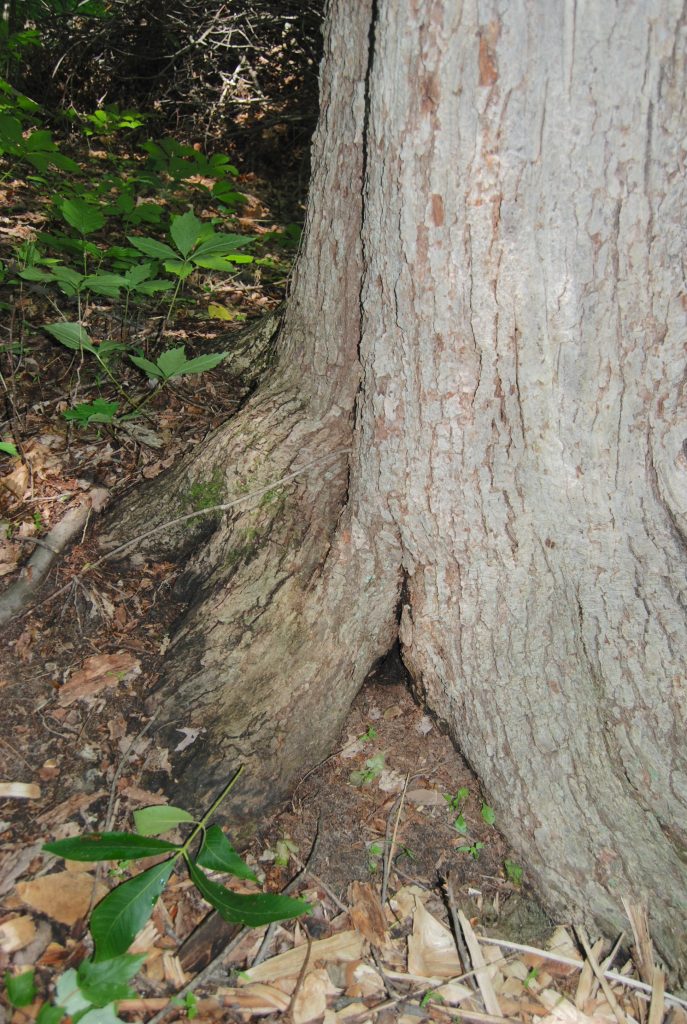
Last year I needed to remove a tree that had long vertical strips of dead bark on both sides of the trunk where a lightning strike had injured the tree many years earlier. On both sides of the tree, I could see that wood decay fungi were at work weakening the tree, and I was concerned that the tree would cause structural damage to a neighbor’s home if it was ever blown over in a wind storm. Therefore, I cut down the tree with the intention using it for fire wood. The stump and felled trunk of the tree showed the extent of wood decay that had moved into areas were the bark had been killed by lightning (Figs. 15-16).
- Fig. 15. Evidence of lighting injury (within the red oval) on the stump of the red maple
- Fig. 16. Trunk of felled red maple showing internal areas beneath lightning-damaged wood where wood decay fungi have invaded.
When I began to section the main trunk of this tree for firewood, I was surprised to see patterns of gray discoloration in cross sections of the trunk that had been 30 to 40 ft above ground when the tree was standing (Fig. 17). Closer examination showed that the gray discoloration rarely extended all the way to either the center of the tree or to the outer bark. When the discolored wood was split lengthwise into firewood, it became apparent that the discoloration was due to fungi that emanated from insect galleries (Figs. 18-19).
- Fig. 17. Discoloration pattern seen in cross-section of the tree trunk about 30 ft above ground.
- Fig. 18. Insect galleries evident in some of the discolored wood after it was split.
- Fig. 19 Additional insect galleries evident in the stained wood.
Based on the photos above along with my observations of additional sections of the tree as I cut and split it, it appears that the lightening strike that caused the two strips of dead bark shown in Figs. 15-16 caused stress throughout the tree that was not visible at that time. However, many wood-boring insects are attracted to trees under stress. The insects that were attracted to my lightning-damaged red maple created galleries that were subsequently invaded by fungi that turned wood brownish gray as the fungi moved upward and downward through the xylem. The damaged tissue was limited to the xylem that was close to the surface at the time when the tree was hit by lighting. New wood tissue that was produced in the 5 to 8 years between the lightning event and the time that I cut down the tree was apparently not susceptible to insect attack, so the cross-section showed damage that did not extend to the outer bark (Fig. 17).
The interesting point in this story was that, while lightning did not kill this tree directly, it inflicted injury that led to wood decay near the base of the tree and that attracted boring insects that invaded wood throughout the tree. Ultimately, the tree had to be taken down because of the lightning strike even though the lightning itself did not directly kill the tree.
(Last updated 27 June 2017)

